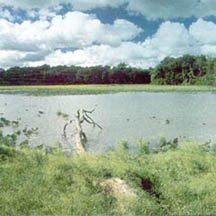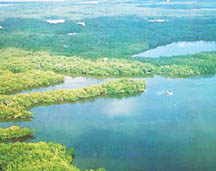
Estuaries... Where fresh and salt water meet
Estuaries are primarily places where fresh water mixes with salt
water. If we go into detail, this fresh water comes from the rivers and
streams, and flows into the oceans. Birds, fish and other wildlife of
many varieties make estuaries their home.

People also live, fish, swim and enjoy nature in estuaries and the
lands surrounding them. Estuaries come in all shapes and sizes and are
called by many different names: bays, lagoons, harbours, inlets or
sounds are some of them.
A tide is a necessary force to maintain a dynamic (active)
relationship at the place where fresh and salt water meet. In non-tidal
seas, the rivers naturally form deltas or leman. Estuaries are more
likely to occur in submerged coasts, where the sea level has risen in
relation to the land, as this process floods valleys to form fjords.
There are three zones in an estuary. The first zone is where the
river begins to meet the salt water. It has more fresh water than salt
water. Next is the middle zone where there is an almost equal mix of
fresh water and salt water. The last zone is where the water begins to
flow into the ocean, and is mostly salt water. Estuaries are protected
from the full force of the ocean by mudflats, sandpits, and barrier
islands.
Do you know what exactly these words mean?
Fresh water: Water from rivers, lakes, reservoirs, underground
streams and other sources. This water is continually lifted from the
ocean through evaporation and is then returned to the land as ice, snow
or rain.

Sea water: Water that comes from the ocean and is very salty.
Barrier islands: A long, narrow island running parallel to the
mainland; built up by waves and currents and protecting the coast from
erosion by surf and tidal surges.
Why estuaries are important
The sheltered waters of estuaries are home to many varieties of
plants and animals that are likely to live in water that is part fresh
and part salty. They include horseshoe crabs, ospreys, manatees,
mangroves and sea grasses.

Hundreds of fish and shellfish, such as scallops, shrimp and salmon
live in estuaries at some point in their lives. Estuaries protect the
water quality by filtering out dirt and pollution. There are lots of
different types of habitats in and near estuaries.
Estuaries are full of decaying plants and animals. This makes the
soil of estuaries rich in nutrients. Because of the richness of the
soil, lots of different plants grow in these areas. These plants attract
lots of different animals.
Common animals in these areas are shore and sea birds, fish, crabs,
lobsters, clams, skunks and reptiles. Estuaries are often called the
nurseries of the ocean; many fish species lay their eggs here. The
abundant plant life in estuaries provides a safe place for young fish to
live.

Birds are also abundant in estuaries. With the variety of plants and
fish, the birds have a lot to eat. Many migratory birds also use these
places as resting and feeding grounds when they migrate. Long-legged
birds like sand pipers, great blue herons, great egrets and green herons
are common in estuaries.
Threats on estuaries
Estuaries are endangered by the polluting of water, and building on
the lands surrounding them. They can contribute to unsafe drinking
water, closing of beach and shellfish beds, harmful algae blooms,
declines in fisheries, loss of habitats, killing of fish and other
resource problems.
Dams can block natural streams and river routes, and cut off fresh
water from estuaries. When that happens, the fresh and salt water
balance of the estuary changes, which can result in serious damage to
the estuary. Development activities can also damage or even destroy
estuaries.
In the past, most people thought that estuaries were waste lands, and
built houses on them after filling these areas. Too many nutrients
coming from the sewage and septic systems harm the estuaries because
then, too much algae will grow.
These algae stop the sunlight coming into the water and block the
oxygen as well. This also happens from the polluted air. Toxic chemicals
and changes in water flows can also destroy estuaries.
Compiled by Janani Amarasekara |


